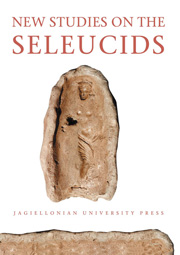Book contents
- Frontmatter
- Contents
- Abbreviations
- Local and Imperial Dates at the Beginning of the Hellenistic Period
- Europos-Doura Séleucide
- Suse et les Séleucides au IIIE siècle avant J.-C.
- Fondazioni di Antioco I Soter in Caria (St. Byz. s.v. Antiocheia)
- Antioco III e la politica onomastica dei Seleucidi
- Wie man ein „Verwandter“ des Königs wird – Karrieren und Hierarchie am Hofe von Antiochos III
- Achaeus, the Ptolemies and the Fourth Syrian War
- Imago mundi: expression et représentation de l'idéologie Royale séleucide. La procession de Daphné
- Nuove considerazioni sul Calendario Cappadoce. Persistenze e adattamenti dell'eredità achemenide nella storia di un piccolo regno tra mondo macedone, seleucide, attalide, partico e romano
- Demetrius III in Judea
- Reviews
Achaeus, the Ptolemies and the Fourth Syrian War
Published online by Cambridge University Press: 05 September 2014
- Frontmatter
- Contents
- Abbreviations
- Local and Imperial Dates at the Beginning of the Hellenistic Period
- Europos-Doura Séleucide
- Suse et les Séleucides au IIIE siècle avant J.-C.
- Fondazioni di Antioco I Soter in Caria (St. Byz. s.v. Antiocheia)
- Antioco III e la politica onomastica dei Seleucidi
- Wie man ein „Verwandter“ des Königs wird – Karrieren und Hierarchie am Hofe von Antiochos III
- Achaeus, the Ptolemies and the Fourth Syrian War
- Imago mundi: expression et représentation de l'idéologie Royale séleucide. La procession de Daphné
- Nuove considerazioni sul Calendario Cappadoce. Persistenze e adattamenti dell'eredità achemenide nella storia di un piccolo regno tra mondo macedone, seleucide, attalide, partico e romano
- Demetrius III in Judea
- Reviews
Summary
The second half of the 3rd century saw the Seleucid monarchy weaken considerably. The reign of Seleucus II brought difficult battles against Ptolemy III Euergetes (the Third Syrian War) and attempts to overcome massive internal problems. During the war against Egypt, he ultimately managed to recapture northern Syria but Ptolemy III held on to the port of Seleucia Pieria, which was key for the Seleucids, and captured a number of places in Asia Minor. It was there that the Seleucids suffered their greatest territorial losses – they lost almost all their footholds on the coasts of Cilicia, Lycia, Caria and Ionia. The Egyptian king even seized Ainos and Maronea on the Thracian coast. What also had an impact on Seleucus II losing his influences in Asia Minor was his fratricidal war against Antiochus Hierax, backed by the kings of Pergamon, Capadocia and Bithynia. The defeated Seleucus had to reconcile himself with his brother's independence in Asia Minor; the latter, however, subsequently suffered a defeat in his war against Pergamon, which ultimately led to the Seleucids losing their Asian Minor territories. The dynasty also faced enormous challenges in the East, where Bactria and Sogdiana seceded, and Parthia was seized by the Parni.
The state's situation did not improve during the short reign of Seleucus III Keraunos, Seleucus II's son and heir. His assassination in 223 during a campaign against Attalus I, the king of Pergamon, became another destabilising factor.
- Type
- Chapter
- Information
- New Studies on the Seleucids , pp. 115 - 124Publisher: Jagiellonian University PressPrint publication year: 2011



